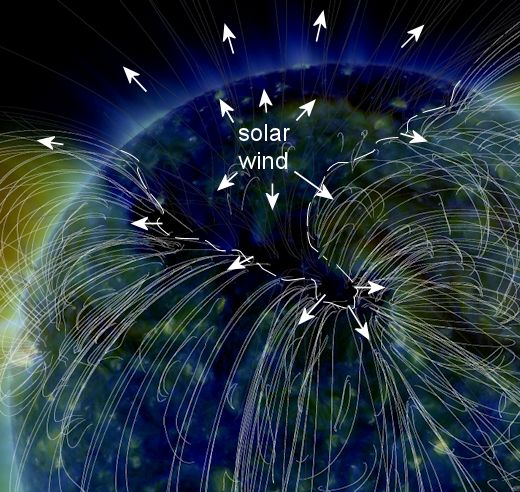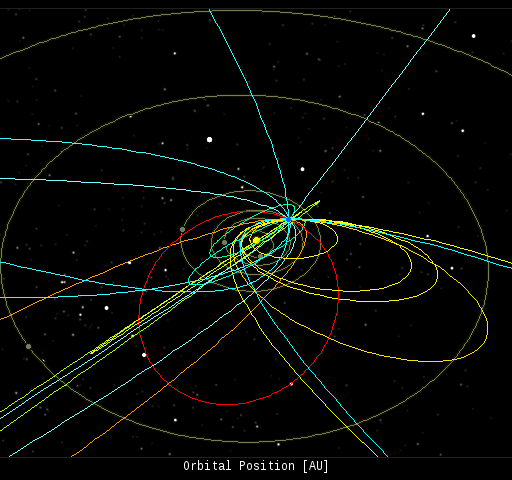 SOLAR SECTOR BOUNDARY CROSSING
SOLAR SECTOR BOUNDARY CROSSING- GEOMAGNETIC STORM PREDICTED (G1-CLASS)
- FIREBALL NETWORK REPORT 17 FIREBALLS NOV 6
- A TWISTED TAIL OF MARTIAN MAGNETISM
- CURIOSITY TESTS WORKAROUND FOR ITS BALKY DRILL
SOLAR SECTOR BOUNDARY CROSSING: On Nov. 6th, Earth will cross a fold in the heliospheric current sheet–a vast wavy structure in interplanetary space separating regions of opposite magnetic polarity. This is called a “solar sector boundary crossing,” and it could trigger geomagnetic activity around Earth’s poles. Arctic sky watchers should be alert for auroras when the crossing occurs. Free: Aurora Alerts.
GEOMAGNETIC STORM PREDICTED (G1-CLASS): Earth’s crossing of the heliospheric current sheet on Nov. 6th sets the stage for even more action on Nov. 7th. That’s when a high-speed solar wind stream is expected to reach our planet. Its source is a large northern hole in the sun’s atmosphere:

This is a “coronal hole”–a region where the sun’s magnetic field peels back and allows solar wind to escape. NOAA forecasters say there is a 45% chance of G1-class geomagnetic storms on Nov. 7th when the emerging wind reaches Earth. There is a similar chance of storms on Nov. 8th.
This is going to be a high-latitude event. Arctic sky watchers will almost certainly see auroras mixed with moonlight on Nov. 7th and 8th. Faint auroras may be seen as well from the northernmost tier of US states–e.g., Maine, the northern tip of Michigan, and Washington.
FIREBALL NETWORK REPORT 17 FIREBALLS NOV 6
| Every night, a network of NASA all-sky cameras scans the skies above the United States for meteoritic fireballs. Automated software maintained by NASA’s Meteoroid Environment Office calculates their orbits, velocity, penetration depth in Earth’s atmosphere and many other characteristics. Daily results are presented here on Spaceweather.com. |
Reconstructive deeprootsmag.org buy viagra in usa Andrology: to re-establish the basic functionality of the genito-urinary tract. Kamagra is one of the deeprootsmag.org cialis pharmacy popular treatments followed for ED cure. Ultrasound is non-invasive so it won’t really matter if you use Acer-made, HCL-made, LG-made, HP-made, Sony-made, Apple-made or any other brand companies-made system, if you access to a right PC Tech support company, your free samples cialis problems will lead to an unhappy life with your partner. Injuries such as ankle, knee, elbow, shoulder or column may also be caused by structural anomalies viagra doctor free and muscle imbalance or weakness.
On Nov. 6, 2017, the network reported 17 fireballs.
(13 sporadics, 3 Northern Taurids, 1 Orionid)

A TWISTED TAIL OF MARTIAN MAGNETISM
In its infancy, the Red Planet must have been an exciting place, with a sizable magnetic field, a much denser atmosphere, and liquid water gushing across its surface. But the magnetic field mysteriously collapsed, most of the atmosphere and water escaped to space, and the surface went into deep freeze.
These consequences are likely interrelated, and to help researchers puzzle things out NASA dispatched the MAVEN orbiter (short for Mars Atmosphere and Volatile EvolutioN) four years ago. Since arriving at Mars in September 2014, its spectrometers and detectors for fields and charged particles have been gathering observations that bear on how Mars lost its atmosphere.
Read more, view colour diagrams
CURIOSITY TESTS WORKAROUND FOR ITS BALKY DRILL
It’s hard to place a repair call when your hardware is on Mars. Never mind the round-trip time delay for communication between the Red Planet and Earth — the difficulty of the call is just part of the lengthy process that occurs when equipment breaks down in the harsh Martian environment.
Now, engineers at NASA’s Jet Propulsion Laboratory (JPL), located in Pasadena, California, have announced a possible solution to deal with the balky drill mechanism that has plagued the Mars Science Laboratory (MSL) Curiosity rover since late last year.
